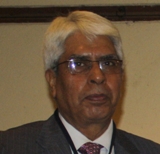Glaciers and Polar Ice Caps
The Himalayan glaciers controversy - An article in Ground Report India
Posted on 01 Mar, 2010 03:36 PMA huge controversy has been generated in recent days over the much quoted lines in the IPCC’s 2007 report: “Glaciers in the Himalaya are receding faster than in any part of the world and, if the present rate continues, the likelihood of them disappearing by the year 2035 and perhaps sooner is very high if the Earth keeps warming at the current rate” (Working Group 2, page 493). We do need to question how a statement of such magnitude, without peer review, made its way into the IPCC report. That it was discovered,externally, more than two years later raises concerns about both the mindset and the weakness of the processes of the IPCC in checking and correcting information they collate, information that is so vital in the global debate. However, to question the credibility of the science of the global warming, supported as it is by a wealth of empirical evidence, or to question IPCC’s work, as is happening in some quarters, is gross exaggeration and sometimes driven by dubious and malafide intentions.
Monthly magazine-Dams, Rivers & People, Sep-Oct 2009, Oct-Nov 2009, Dec 2009 - Jan 2010
Posted on 25 Jan, 2010 12:56 PM
Speakers and presentations at the IWMI : Bharat Sharma speaks on the use of GIS for estimating basin level water productivity
Posted on 07 Dec, 2009 02:25 AM

Findings of Basin Focal Project on the Indo-Gangetic basin
Posted on 02 Dec, 2009 02:34 PMNo! This title isn't mine. I borrowed it from Mahmoud Darwish's literary work of the same name.
Effect of climate change on river Kosi and its basin
Posted on 28 Aug, 2009 02:46 PMKosi is one of Ganga's largest tributaries and in turn is fed by 7 tributaries - Sun Koshi, Dudh Koshi, Indravati, Tama Kosi, Likhu, Arun, and Tamar. These tributaries encircle Mt Everest from all sides and are fed by world's highest glaciers. The river drains a total area of 69,300 sqkm upto its confluence with Ganga. The river basin stretches 54,000 sq.kms.
Effect of climate change on the Ganga-Brahmaputra delta regions
Posted on 28 Aug, 2009 02:28 PMThe delta belt is home to approximately 125-140 million people. And over 300 million people are supported by the delta. The density of population in the Delta region is 200 people / sq.km. making it one of the densest regions in the world.
The delta region is a high-rainfall region and receives 60-80 inches of rainfall every year.
Quick reference: Climate change impacts on freshwater ecosystems in the Himalayas (CCIFEH)
Posted on 26 Aug, 2009 04:01 PMThe programme entails a panorama of actions working towards understanding future climate change impacts on Himalayan river ecosystems and vulnerable communities for the development of adaptation strategies; implementation of pilot sites; and raising the awareness of climate change impacts on Himalayan river basins, in addition to urging specific adaptation strategie
Glacier lake outburst floods: Wrecking havoc to life and property in the Himalayan region
Posted on 26 Aug, 2009 03:47 PMThese floods cause havoc with human life, flora and fauna of the area and the infrastructure in the region.
The Dig Tosho Glacier lake outburst in August 1985, destroyed the nearly completed Namche hydropower plant and all the rails, roads, and other infrastructure in its course.
How climate change has affected Ladakh: The region has seen unusual floods in July 2005 and August 2006
Posted on 26 Aug, 2009 03:36 PMIt is in Jammu Kashmir and is bordered by the Himalayas and the Karakoram mountain chains. Ladakh and its water sources are almost entirely dependent on the glaciers and snow-melts and changes in water systems can be directly attributed to changes in the glaciers and thus climate change.
Impact of climate change on the Himalayan glaciers
Posted on 26 Aug, 2009 03:30 PMThe Himalayas' permanent ice cover is around 97,000 sq.km. with 12,930 sq.km. volume of ice and snow: 10-20 % are covered by glaciers and 30-40% are seasonal snowfalls. The Himalayan streams and rivers are fed by the melting of snow and ice of approximately 500 sq.km / year.





